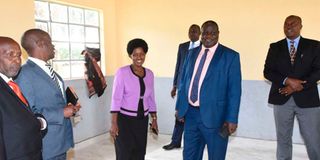Unions want junior high domiciled in day schools

Education PS Julius Jwan (2nd right) and other officials inspecting a CBC classroom at Moi Girls High School in Eldoret. Two teachers’ unions have asked the government to reconsider the decision to use boarding secondary schools for junior high, citing the tender age of the transitioning learners.
Two teachers’ unions have asked the government to reconsider the decision to use boarding secondary schools for junior high, citing the tender age of the transitioning learners.
The Kenya Union of Post Primary Education Teachers (Kuppet) and the Kenya National Union of Teachers (Knut) want the government to domicile junior secondary in day schools.
The unions said learners in this level may not get along well with those in Forms One to Four under the current 8-4-4 system owing to the age difference.
Learners who will be transitioning to Grade Seven, the first class of junior secondary, have been selecting their preferred schools, with the two unions raising concerns that most of the available slots are in boarding institutions.
Help ease strain
Kuppet Executive Secretary Sabala Inyeni, speaking in Mbale town, Vihiga County, said the proposal to domicile junior secondary in day schools only would help ease the strain on existing facilities.
Speaking separately, Knut Executive Secretary Maurice Chalenga agreed with his Kuppet counterpart, arguing that the minors should only move to day schools.
Said Mr Inyeni: “In January we expect junior secondary classes to begin. We are concerned that we don’t have enough facilities. The children who are expected to transition to junior secondary and who will join the current secondary schools will not be able to cope with the rest due to the big age difference.”
He added that allowing the young learners to join the older ones could lead to bullying and other social issues.
Limited slots in top schools
The more than 1.28 million learners who are expected to join junior secondary in January next year will compete for limited slots in top schools. An almost equal number of learners who are under the 8-4-4 system will join Form One at the same time in a double intake that is expected to stretch school resources.
Outgoing Education Cabinet Secretary George Magoha has been criss-crossing the country and commissioning classrooms that he said are meant to host junior secondary learners.
Prof Magoha has also repeatedly assured the country that the classes will be ready for use by the time the transition begins, but Mr Chalenga doubts the ministry’s preparedness.
“There is an age challenge because most of the learners in Grade Six are still underage. Most of the schools they have been asked to select are boarding schools. They will be disadvantaged by age as they may not cope,” said Mr Chalenga.
“The government must burn the midnight oil to ensure all is well,” he added.
Cut-throat affair
Transition to secondary school is always a cut-throat affair, with well-performing schools in high demand. But for the first time, the ministry will place learners in private schools based on their selection.
A report by the task force on enhancing access, relevance, transition, equity and quality for effective curriculum reforms implementation projected that there will be a shortage of 1,489,144 places in secondary schools. This would require 29,783 extra classrooms to fix. Over the past four years, secondary schools have had to grapple with congestion, owing to the introduction of the 100 per cent transition from primary to secondary school.
Whereas many parents and learners would prefer national schools and other top schools, these are few and the majority of learners will be admitted to sub-county schools, which are primarily day schools.





